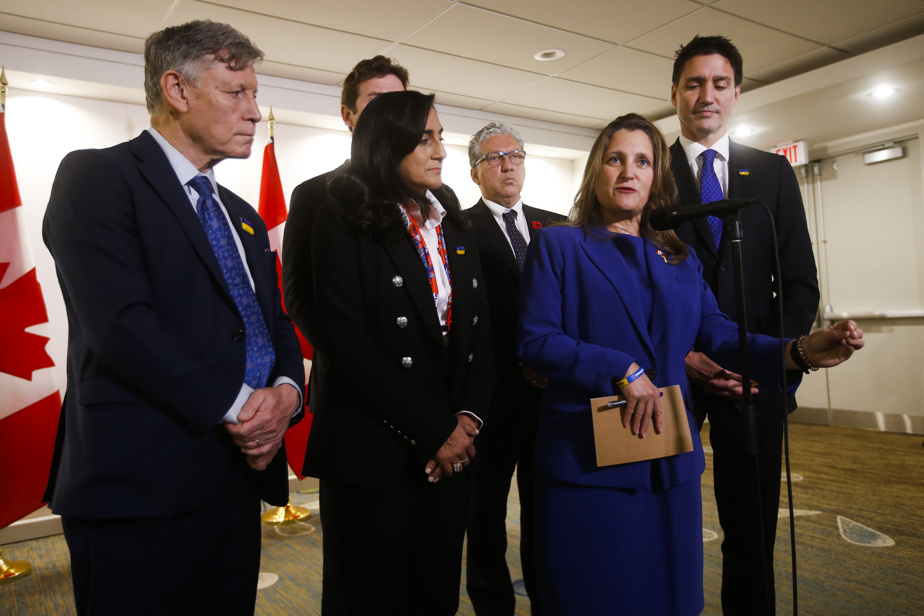
(OTTAWA) Finance Minister Chrystia Freeland will deliver her diagnosis on November 3 when she presents the health of the Canadian economy and the bleak outlook she anticipates in the coming months in the House of Commons.
Posted yesterday at 8:00 am
Minister Freeland will present his economic statement in a very difficult context. Inflation is high, interest rates are rising, the economy is showing signs of slowing and the NDP, which secured a political deal that ensures the survival of the minority Liberals in the Commons until June 2025, is pushing for increased spending to strengthen social. Safety net including employment insurance program among other things.
The provinces were not left out. They have just launched a new national campaign to force Ottawa to significantly increase health transfers ($28 billion a year) when the health network is more fragile than ever after two years of the pandemic.
Mme Freeland also files her statement at a time when economic conditions in Ottawa are beginning to improve. The federal government posted a budget surplus of $3.9 billion (see below) in the first five months of the 2022-2023 fiscal year (April to August), compared with a deficit of $57.2 billion for the same period from 2021-2022.
Over the past few weeks, Minister Freeland has made a number of announcements to set the stage for the announcement of bad news in the financial sector.
She noted that the Canadian economy is set for new turbulence due to a sharp increase in the Bank of Canada’s key rate, which is trying to keep inflation above the target range of 2% to 3%.
This sharp rise in interest rates will inevitably cause a slowdown that affects families, workers and businesses, as well as raising borrowing costs for those looking to buy a home or vehicle.
Not everyone can get help
“Ottawa needs to impose greater budget austerity on itself to avoid fueling inflation,” she said, adding that the government has not provided everyone with a fiscal stimulus like it did during the pandemic.
Finally, she advised her cabinet colleagues that they needed to tighten their belts. They must fund any new program they propose from their department’s current budget.
The minister never uttered the word “recession” even though many economists claimed that the country could not escape it.
This week, the Bank of Canada raised its key rate for the sixth time this year, a half-point rate hike that took its key rate to 3.75%.
In its latest report on monetary policy, the firm revised its economic forecasts. Economic growth is expected to stagnate at the end of this year and between 0 and 0.5% in the first two quarters of 2023, before picking up in the second quarter of 2023. She also mentions that there is a slight possibility of convulsions.

Photo by Adrian Wilde, Canadian Press
Parliamentary Secretary to the Minister for Finance and Member of Parliament for Outremont Rachel Bendayan in the House of Commons on Friday
In the Commons on Friday, Rachel Bendayan, parliamentary secretary to the finance minister, argued that the fiscal statement demonstrates that the Trudeau government intends to exercise budgetary discipline. “This fiscal update is being fiscally responsible. We have the lowest deficit in the world. We’re at 1% deficit. We were fiscally responsible in our April budget. We always will be and we’ll be there to help Canadians during this time of economic instability,” she said.
Fiscal discipline is vital as the country faces high inflation, rising interest rates and weak economic growth, according to Robert Asselin, senior vice-president of the Business Council of Canada.
“The focus must now be on fiscal prudence to ensure that the central bank can bring inflation back to its target range,” said Asselin, a close aide to the former finance minister. Bill Morneau.
3.9 billion surplus in Ottawa
The federal government posted a $3.9 billion surplus for the first five months of its 2022-2023 fiscal year. The Finance Ministry, in its monthly fiscal review, indicated that the surplus was recorded between April and August compared to a deficit of Rs 57.2 billion for the same period last year. Government revenue totaled $177.2 billion during the period, up from around $149 billion a year ago amid widespread growth. Program costs excluding net actuarial losses were $154.5 billion, compared to $190 billion for the same period last year. Public debt charges for the period were about $14.8 billion, up from about $9.7 billion. Net realized losses came in at around $4.1 billion, down from $6.4 billion recorded a year earlier.
Canadian Press






